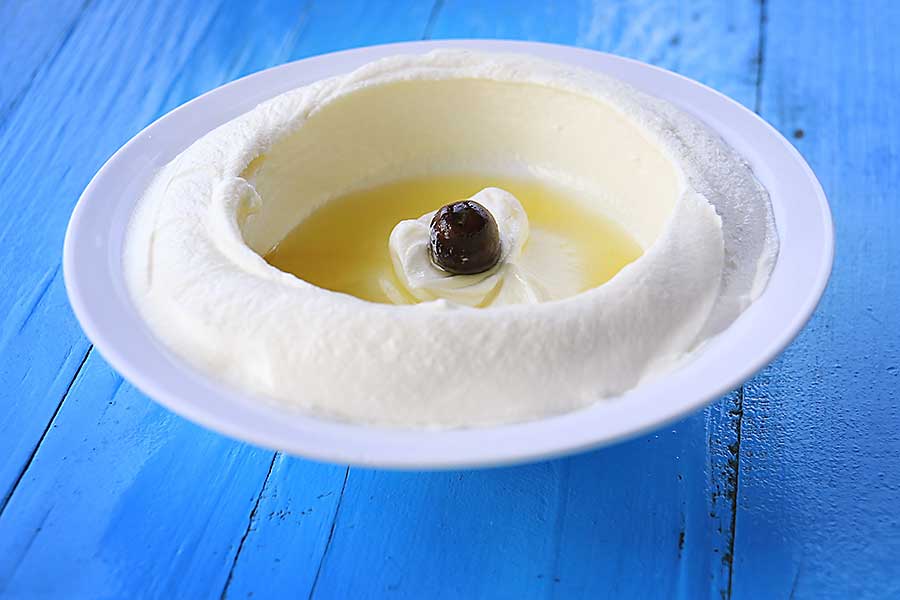Labne or labneh
Labneh (also known as labneh, labni, lebni or zabedi) is the name of a popular thick yoghurt in the Middle East. It has been consumed in the levant region of Lebanon, Syria, Jordan, and Palestine for thousands of years. You can find labneh both in a dried form or steeped and marinated in olive oil. Cow or camel milk is traditionally used to produce labneh, although you can also find labneh made from goat or sheep milk. The type of milk used will greatly influence the taste and texture of the labneh.
As labneh increases in popularity, it’s being used in less traditional ways by more inventive chefs. This includes labneh being blended into a calabaza (type of pumpkin) soup or used to make cheesecakes. In some instances, vegan labneh is being produced out of cashews. While labneh is getting increasingly trendy, it’s still difficult to find outside of Middle Eastern shops and markets.
How do you make labneh?
Labneh is very simple to make, with many different techniques used to achieve varied textures and flavours. An easy method is to sprinkle salt into freshly made yoghurt (ideally from raw milk) and strain through a cheesecloth. The yoghurt is left to strain for 24 hours before it is ready to eat. Flavourings, such as garlic, chilli, mint, za’atar, or dill, can also be added to the final product.
Using the above method, labneh can last up to two weeks. To make labneh last a couple of months, it can be rolled into balls and preserved in olive oil. This is known as ‘labneh bil zayt’, or ‘labneh in oil’. The longer the labneh is left to sit in the oil, the more acidic it will taste. If you choose to store your labneh this way, try to roll the balls in herbs like za’atar, mint, or dill before dunking them in the jars of olive oil.
How do you eat labneh?
Labneh is an extremely versatile yoghurt that can be eaten as an appetiser, part of a mezze plate, or consumed for breakfast. It is a staple ingredient that’s consumed as part of a typical breakfast in the eastern Mediterranean and Middle East, especially in Turkey, Lebanon, Syria, and Israel or Palestine. For breakfast, labneh is most often consumed when garnished with olive oil and za’atar.
Labneh is also extremely popular as part of a traditional Middle Eastern mezze platter, a style of shared plates similar to tapas. Here you might find labneh being served alongside falafel or used as a dip for fresh or crisp bread. A traditional way to eat labneh is to drizzle it with yoghurt and add a sprinkling of za’atar before serving.
What’s the difference between labneh and greek yoghurt?
Both greek yoghurt and labneh are types of yoghurts that have been strained to remove at least half of the whey. Labneh, however, is usually more strained than Greek yoghurt which makes it much thicker and more spreadable. Greek yoghurt is much lighter than labneh with a silkier texture. Labneh is also consumed differently to Greek yoghurt. It is mostly used in a savoury manner, seasoned with salt and lemon juice or olive oil and za’atar. Because labneh is a more highly concentrated yoghurt product, it is also higher in protein than Greek yoghurt.
What is a good substitute for labneh?
If you’re using a recipe that calls for labneh, but cannot find any, you can substitute it with numerous other yoghurts. Our first suggestion, of course, is to attempt to make your own labneh from scratch using the method above – it’s quite easy! If you don’t have the time to make your own labneh, you can substitute it with greek yoghurt, cream cheese, mascarpone, or sour cream. What you choose to substitute labneh with will depend on the recipe and whether it’s leaning towards sweet or savoury. The texture of labneh is most similar to cream cheese yet its flavour is more sour than greek yoghurt.
Private Chefs, Art of Dining
CHEFIN is a private chef platform that’s reimagining social dining.
You can easily connect with 1 of our 250 private chefs and treat your guests to restaurant-quality dining experiences in the comfort of your own home, office or chosen venue. From high-end dining to quirky social food experiences, the CHEFIN platform makes it effortless for you to access gourmet food that’s worthy of a Michelin-starred establishment.
What you get:
-
- Your very own private chef who is vetted and insured,
- A customised menu for your needs,
- 24/7 concierge support,
- Complete post-dinner cleanup,
- A fun, stress-free, and unforgettably dining experience!


